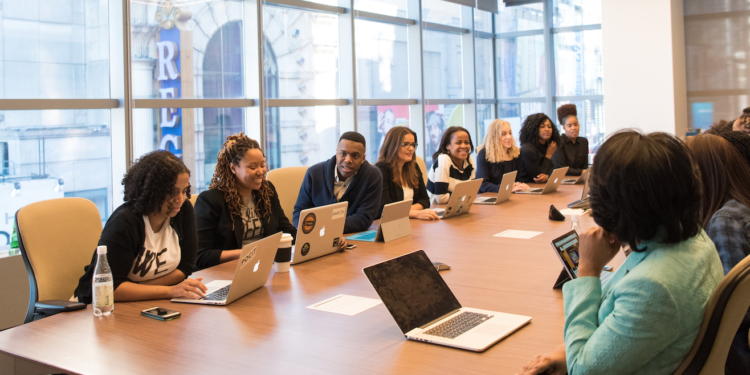How CEOs Can Lead Better If They Shed Myths of the Middle Class and Invest in Workers

The post-WWII middle class boom benefited significantly from the entry of more women of all races and non-white men. (GM)
All authors want their books to feel relevant, but Jim Tankersley didn’t want his, “The Riches of This Land,” to do so because of a national crisis.
The New York Times economics reporter drew from years of research and interviews to explore the struggle of the American middle class. His narrative focuses on how the so-called “Golden Era” of the post-World War II economic boom was significantly powered by the lowering of barriers for women of all races and non-white men, and that an inclusive, worker-centric approach to business is the way to once again capture some of that growth and benefit all Americans. The 2019 study by three University of Chicago economists and one from Stanford is at the heart of the book is titled “The Allocation of Talent and US Economic Growth,” and among its findings is that 40% of the U.S.’s per-worker economic growth can be directly tied to reducing discrimination since 1960.
Tankersley also shows how subsequent myths about the middle class boom helped once again entrench inequality in the country for the past 40 years – complemented by the reign of shareholder primacy in corporate finance. And so when a pandemic hit, disproportionately affecting Americans across race and class, his book draft needed an update.
“It’s one thing to frame a book about how the middle class has been struggling even as the economy has been steadily, but far too slowly, improving through a 10-year-plus recovery,” he recently told JUST Capital over video chat from his home in Washington, DC. “And it’s quite another thing to say, ‘Oh my gosh, we are now entering the second once-in-a-lifetime-crisis of our lifetimes.” He sent last minute updates to the publisher in March, and they turned out to be even more relevant following the ongoing reckoning with racial equity since the George Floyd protests began in late May.
In the interview, we discussed what Tankersley wants readers to take away from “The Riches of This Land,” and focused particularly on how corporate leaders can use extrapolate lessons from it to build not only stronger companies, but a stronger American economy.
The following transcript is edited for length and clarity.
Jim Tankersley: At the very core of the book is an argument to all Americans, but particularly working class Americans. I wanted to tell a story that made the argument that workers are not locked in a zero sum competition against each other in the American economy, that in fact the opposite is true. We can have a growing pie and a more equitably distributed pie when people are able to use their full human talents to the full use of their ability. It doesn’t seem like a radical thought when you put it that way, and yet, when I look at the way we talk about economics in this country, you get the sense that workers are always in competition with each other for some finite number of jobs.
It’s just not true. It’s just not what history shows us is true. It’s not it’s not what my lived experience and my reporting experience shows us is true.
Vast swaths of the country have been frustrated, over the last couple of decades in particular, over the way the economy has been performing. It could perform better, and we know and the way to do it – stop pitting workers against each other and start investing in them.
Feloni: Related to that is the debate over how capitalism has played out over that time, and we take a look at the past 50 years of the American economy and the role that business has played in that. When that is discussed, that “Golden Era” of the post-World War II boom is sometimes spoken of like an ideal version of capitalism that we could go back to. Rebecca Henderson has joked a friend told her that it would be great to have that version of capitalism without the racism and misogyny. But there’s some myth-making to that, as well. I’m curious what your feelings are in terms of when we were talking about a better form of capitalism and what we can learn from the past on that.
Tankersley: The Golden Era, as you just called it and as I call it in the book, wasn’t perfect. Obviously it was not an ideal version of capitalism. It was definitely still an economy that was highly discriminatory – it was just less discriminatory than it had been. We have to remember that.
There are also a lot of people who say, “Oh, well, WWII and the postwar boom was a one-off period that we can’t have again.” To me, that’s just defeatism.
The way I would put it is that era shows us what is possible, and we can even imagine better. We’ve done it before and we can do it again, and then we can go beyond it. But we have to be honest about what we’ve created in the first place, and I’m very critical of economic nostalgia in the book.
Lessons to take from the ‘Golden Era’ of the middle class
Feloni: So what do we want to take from that era into today?
Tankersley: There’s two big things.
One of them is mechanical macroeconomics. We had a long stretch of low unemployment and strong economic growth, and that produced a lot of worker power to demand raises and that income growth helped everybody. It was self-sustaining. Jared Bernstein, the economist, likes to say that’s sort of a magic formula.
So how did we get that? Well, we got that in part because of the industrial mobilization of the war and the industrial landscape of the postwar, but 40% of the growth that the country’s had per worker since 1960 has come from a very specific type of productivity boost, and that came from being as discriminatory as we used to be. And then there was a, a big burst with civil rights. The economy had previously closed off most of its really lucrative, highest skilled jobs, and much of the highest rungs of its educational system, to all but white men.
So when we corrected that, when we started allowing women and Black men to be doctors, and we started bringing in more highly skilled immigrants, these things all contributed to what the economists behind this research call a better allocation of talent in the economy. It’s this idea that we want people to do what they’re best at and when they can, wow, it unlocks growth and then rising incomes for everyone.
When the economy reduces barriers to advancement for women of all races and men of color, we all get ahead.
How CEOs can use this information to their advantage
Feloni: And so what are some actions that you think can be taken and that you are hopeful can be taken, especially for our corporate audience?
Tankersley: The first and most important thing that companies can do is start thinking about their workers again as renewable resources to be invested in. Especially in a time of long stretches without a tight labor market, it’s easy for companies to treat employees like they are disposable, pay them as little as possible, invest as little as possible in training them, and you can always find someone else if they leave.
But the evidence shows us there are huge advantages across the economy to companies investing in their workers, in training, and – this is the big thing – in the systemic change that allows previously oppressed groups of workers to get ahead.
Companies need to have more than just lip service about diversity efforts. They need to be looking at every point in their organizational systems and asking, what are we doing here to block women? Is there something in the way we handle maternity leave that makes it difficult for mothers to come back and continue to excel at our company? Why do we not have as many Black executives as the population or even the college education numbers would suggest that we should? What are the networks that exist to get people into this company that might exclude talented applicants? Those are all things that government doesn’t have to do, are business practices that if we had a real national effort to them would help everyone.
What it will take to rebuild the middle class
Feloni: I would say that there is an ongoing tension where we can say one of the keys to this flourishing middle-class would be union power, even though it has been thoroughly destroyed in our country, despite a resurgence in favorability among Americans. Do you see a potential resurgence happening, or are we just going to continue to see CEOs try to step ahead of it? What if they said they would start investing more in workers while still pushing against organizing?
Tankersley: One thing that we know for sure is that it’s important for workers to have bargaining power, and it’s easier for workers, whether they’re in a union or not, to have bargaining power when labor markets are tight. There is a really important goal for policy in the union debate here, and unions are definitely a part of that story of the Golden Era.
I define the middle class as an economic security basket – can you afford a home, transportation, education for your kids, retirement savings, and healthcare? If a company is providing its workers with the means to achieve all of that through good middle class jobs. that’s really a step forward. I do think, however, part of the stability that people enjoyed in earlier decades was the feeling like they weren’t going to get laid off at the drop of a hat. And so worker protections, whether they come from union bargaining or from some other place in the workforce, contribute to people’s sense of economic security in ways that you can’t really quantify with income stats.

New York Times economics reporter Jim Tankersley is the author of “The Riches of This Land.”
Focusing on the ‘skills gap’ is not the answer
Feloni: And in terms of achieving more equity of opportunity across race, gender, and class, one thing that has come up a lot when I’ve interviewed CEOs is the key to raising productivity is going to be through reskilling initiatives and bringing back apprenticeships. A lot of times they’ll even bring up the idea of what that system in Germany, for example, is like. I’m seeing you smirk on that! Is any of this worth looking at?
Tankersley: I don’t think reskilling is super important and that the way it’s been deployed in the economic debate in the last 10 years has been really damaging. Companies, and business lobbyists particularly, were crying about a skills gap back when there was clearly a huge amount of slack still in the labor market, and I think it was an excuse not to pursue tighter labor markets. I understand the desire of companies to want to have workers who will do exactly the job they want done for exactly the wage they want to pay for it. I get it. I mean, I would like to be able to walk down and order a beer at my local bar for exactly how much I want to pay for it. But we live in a market based system. That’s not how it works.
I covered a lot of the skills gap stuff back in 2010, 2011. It’s both true that it was weaponized in a bad way, and also true that we just have completely lost the plot on thinking about skills and workers in America. We sort of have a de facto skills system, where people are told to go to college. The college premium absolutely opened up, but it hasn’t really changed in the last couple of decades. College-educated workers with a bachelor’s degree or less, particularly if you’re looking at nonwhite ones, did not have a good 2000s or 2010s at all, except for relative to non-college workers.
I worry about our complete inability to take, you know, the, the manufacturing workers who lost their jobs in the ’90s and the early 2000s, many of them ended up in lower value work where they were getting paid less and were less fulfilled with what they were doing. Nobody spent the time A) investing in their skills to train them to do better things, but B), and more importantly, it was never like, “OK, we have all of these workers suddenly flooding our labor market who are really good with their hands, what is a market optimal way to use to deploy them? What are some innovative things we can do with those workers to take advantage of their skills?”
I smirked about Germany because you hear a lot of know these international comparisons, and I’ve certainly made many of them myself, they’re not wrong. It’s just that those countries, whether it’s Germany or Denmark or whatever, have different ways of approaching the educational and skills question through the entire span of a lifetime, from childhood all the way through college or advanced secondary skills training, and then into the workforce. We do not have that sort of a holistic approach at all. Companies don’t really have it. Government doesn’t really have it. Community colleges to some degree are filling that, and they are really important, very rarely talked about component of this.
But it’s not an easy thing to completely shift your entire national focus about education in ways that are empowering for workers and beneficial for companies, where you don’t just end up with workers having less bargaining power, and instead end up with companies actually having exactly what they need and the economy having better uses for our people, no matter what’s going on with the macro trends.
Rethink corporate culture – for the sake of your business
Feloni: Drawing from your research from your book, what are things that businesses can be doing during this slowdown, when companies are rethinking where they go from here, and how do we become more resilient?
Tankersley: On the one hand, a crisis is never the time when you want to be completely overhauling your system. But I would start with what I said earlier, which is a a root to branch asking yourself what are, what are the systems and structures that exist in our company? Where all the ways that we push away talented people, in particular non-white men and women of all races?
And then the second thing is that maybe now is a great time to start replenishing your pipeline. The upside of so many million Americans out of work is that you can start going out and really trying to find, or you can be ready for when you’re hiring again?
So much of, this is about culture. People ask me, “Well, why did we learn a very whitewashed history of the middle class?” Well, it’s that culture and the history books were set by white men.
The majority of executives in the United States are white men and they can ask how they can they be agents of change with the knowledge that it will make their company better. There’s really fine line between doing diversity for diversity’s sake and doing diversity for improvement of social and corporate outcomes. Companies should be more transparent about the ways in which becoming more diverse is good for their business, and it speaks less to how it helps an individual company and more to how it helps the macro economy.
There is a backlash against the idea that wokeness is ruining corporate culture. Companies need to stand up and not just virtue signal with their diversity efforts, but truly get the message out that, “We’re doing this because it’s going to make us more money and it’s going to make our workers more money.” That would really help. Some of the people who are most likely to attempt to block change and progress on this front would respond with, “We get it, you’re responding to the profit motive here.” And the profit motive is the same in the micro as it is in the macro – it’s a bigger pie for everybody, if have more talented people. Discrimination is a massive market failure, and we need to get rid of it.
Feloni: And it’s similar to messaging on investing in your workforce as opposed to just replacing them as cogs in a machine.
Tankersley: Yeah, totally. Which, by the way, does not mean avoiding automating tasks that should be. We’ve learned in the last 30 years that some technology has been very complementary for some worker and made them much more productive, even if that’s meant replacing others. If we suddenly don’t need six people in that division, we only need three because we have new technology, well ask yourself then, where can we make good use of the skills of people in that division?
What American history shows us is, in general, when people of a particular skill class lose their job – until this most recent 30 year period – what does tend to happen is that they end up finding higher skilled work to do. Companies have not aggressively looked for those opportunities. They’ve treated those people like disposable plastic water bottles.
Someone’s going to unlock how to put those workers to work in more innovative, more productive, better ways that are fulfilling for workers. And it’s going to be great for that company and then for the economy as a whole.






